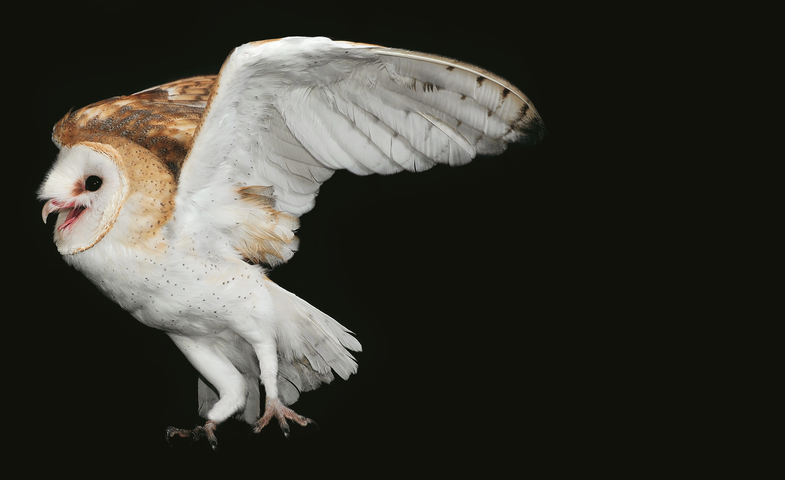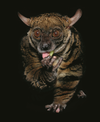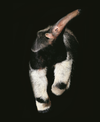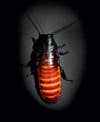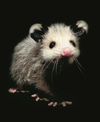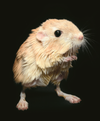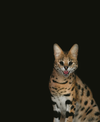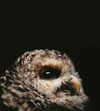Small-Eared Galago
Galagos, more commonly known as bush babies, are tiny African primates with remarkable jumping abilities. Thanks to elastic energy stored in the tendons of their lower legs, small-eared galagos can jump six feet straight up in the air. Long, humanlike fingers with disks of thick skin at the tips also help galagos to hold on to tree limbs as they climb and jump from branch to branch. Galagos are seen almost exclusively at night; the word for this nocturnal animal in the Afrikaans language is nagapie, meaning “little night monkey.”
Giant Anteater
The bizarre-looking giant anteater, also sometimes known as the ant bear, is generally five to seven feet long and can weigh up to one hundred pounds. The giant anteater has an elongated snout and a two-foot-long tongue, but no teeth. The anteater uses its sharp claws to rip open termite or ant mounds and then inserts its long snout into the cavity. Huge salivary glands in the mouth produce very sticky saliva that coats the tongue. As the tongue flicks in and out, insects stick to it and are carried into the anteater’s mouth. One giant anteater may eat as many as thirty thousand ants in one night! The giant anteater is known to be either nocturnal or diurnal, depending on climate and the proximity of humans, but most sleep during the day and feed after sunset.
Indian Flying Fox
The Indian flying fox, one of more than 1,100 species of bats, is also known as the giant fruit bat. Found mainly in tropical forests on the Indian subcontinent, this spectacular mammal usually resides in a treetop colony with hundreds or sometimes thousands of other bats. This species can have a wingspan of up to six feet while weighing in at just three pounds or less. These megabats leave the roost about an hour after sunset and will often fly up to forty miles at night to forage for figs, mangoes, bananas, and other ripe fruit.
Madagascar Hissing Cockroach
Found only on the island of Madagascar, these giant, wingless cockroaches can reach three inches in length. Their characteristic snakelike hissing sound is used to ward off predators and is produced by forcing air through abdominal respiratory openings. Madagascar hissing cockroaches live in colonies and will often hiss in unison, producing a loud, intimidating noise. Males are quite aggressive and have horns, which they frequently use in battles for dominance with other males. Like all cockroaches, the Madagascar hissing cockroach is nocturnal, but males can sometimes be seen fighting during the day.
Opossum
These marsupials have adapted a notorious, theatrical defense mechanism that is exhibited when they are threatened or injured: playing dead. Apparent death, as it is scientifically called, is an involuntary physiological response similar to fainting that causes the opossum to appear and smell like a dead or dying animal, thereby deterring predators who generally prefer live prey. An opossum will remain unconscious anywhere from thirty minutes to four hours. These nocturnal foragers have a very flexible diet and are able to eat rodents, vegetables, fruit, insects, slugs, human scraps, cat and dog food, and even the bones of the roadkill they consume.
Barn Owl
During the day, the aptly named barn owl tends to roost in dark, quiet places, such as abandoned barns and thick trees, emerging only at dusk to hunt small mammals by flying over open fields, marshlands, and meadows. A strictly nocturnal hunter, the barn owl does not rely on sight to find prey but instead hunts by sound. Barn owls have acute hearing, and they can even detect movements of small prey under ground cover such as leaves or even snow. Several unique biological adaptations contribute to the barn owl’s sensitive hearing, including a very pronounced facial disk, which collects sounds and guides them into the ears. In addition, barn owls’ ears are set asymmetrically, with one higher than the other, which helps them to judge the distance and direction of sound in the darkness.
Rococo Toad
These enormous toads can reach one foot in length, making them the largest species of wild toad in the world. Native to South America, the rococo toad can live for up to thirty-five years, eating insects, mice, fish, or even small birds. When threatened, the rococo toad inflates its body to become even bigger and makes huffing noises. The rococo toad is frequently mistaken for the highly toxic cane toad, which is also nocturnal.
Kangaroo Rat
The charming kangaroo rat is not actually related to a kangaroo but is so named because of its bipedal anatomy and kangaroo-like hopping tendencies. In addition, kangaroo rats also have pouches, but these pouches are on the outside of their cheeks rather than on their bellies and are used for transporting seeds, not offspring. Well adapted to life in the North American desert, the kangaroo rat does not need to consume water but is able to get all of its necessary hydration from the seeds in its diet. The rats’ nocturnal lifestyle helps them to stay cool; they sleep in underground burrows during the scorching desert days, only becoming active at night, when the temperatures are lower.
Serval
These elegant cats were once worshipped by the Egyptians for their grace and strength. Despite being barely twice the size of an average house cat, the serval is the most effective hunter of all wildcats, with successful kills approximately half of the time. (In contrast, lions have a hunting success rate of less than 20 percent.) With the longest legs relative to body size of any wild cat, the serval is also one of the fastest, able to run at speeds up to fifty miles per hour. Servals are solitary nocturnal hunters; they primarily prey on rodents but are also known to eat birds, reptiles, fish, and frogs.
Barred Owl
Fossils of the barred owl from up to eleven thousand years ago have been found in the United States and Canada. Barred owls do not migrate; they live year-round in mature forests with a mix of deciduous and evergreen trees. These noisy raptors are very vocal, and during courtship they will often communicate through myriad sounds, including hoots, gurgles, cackles, and caws. Like most owls, barred owls are nocturnal hunters, but their trademark eight-to-nine-note call can sometimes be heard during the day. The hooting call of the barred owl is said to sound like the phrase “Who cooks for you? Who cooks for you all?”
